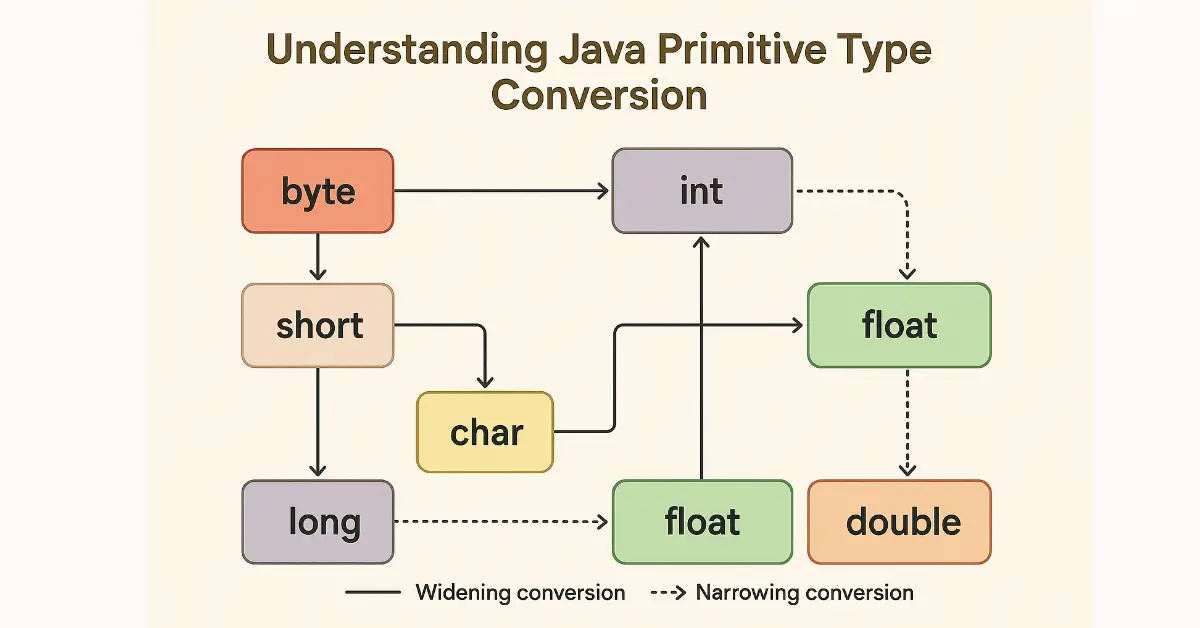Introduction
Java’s primitive data types—int, float, double, char, boolean, etc.—form the backbone of the language. Understanding how and when to convert between these types is essential for writing accurate, efficient, and bug-free Java code.
In Java, type conversion (also known as type casting) ensures data compatibility and safe handling of different data types. Whether you’re handling user input, performing calculations, or optimizing memory, mastering type conversion is a must.
What is Type Conversion?
Type conversion is the process of converting one primitive data type into another. There are two types:
- Implicit (Widening): Performed automatically by the compiler.
- Explicit (Narrowing): Done manually by the programmer.
Why It Matters:
- Prevents data loss
- Increases code reliability
- Optimizes memory usage
- Improves program performance
Implicit Type Conversion (Widening)
In widening conversion, smaller types are automatically converted to larger ones without data loss.
Example:
int num = 100;
double result = num; // int to double - implicit
Widening hierarchy: byte → short → int → long → float → double
This automatic process improves compatibility between types and simplifies mathematical operations.
Common use cases:
- Calculating with mixed data types
- Passing arguments to methods expecting larger types
Explicit Type Conversion (Narrowing)
Narrowing conversion must be done manually using casting. It involves converting a larger type into a smaller one, which may cause data loss.
Example:
double value = 9.78;
int result = (int) value; // explicit cast, result is 9
Risks:
- Loss of precision (truncation)
- Overflow or underflow if value exceeds target type’s limits
Use narrowing only when you’re sure about the value range or have appropriate validation logic in place.
Common Scenarios & Use Cases
Here are real-world examples where type conversion is essential:
- Handling form inputs:
String input = "42"; int number = Integer.parseInt(input); // String to int - Mixed-type calculations:
int a = 5; double b = 4.5; double sum = a + b; // int is converted to double - Working with APIs and legacy systems where data types don’t match
Always prefer implicit conversion when accuracy isn’t at risk. Use explicit casting when necessary, but be cautious and validate.
Best Practices for Type Conversion
- Validate before casting: Ensure the data fits within the target type range.
- Prefer widening over narrowing to avoid unexpected data loss.
- Use wrapper classes like
Integer,Double, etc., for safe parsing and conversions. - Test edge cases (e.g., max/min values) when narrowing types.
Conclusion
Java primitive type conversion is fundamental to safe, efficient programming. Whether you’re writing low-level data-handling code or building scalable applications, a solid grasp of type conversion helps you write cleaner, more reliable code.
Master it through real-world practice and use tools like IDEs and debuggers to inspect type behaviors during execution.
Additional Resources
- Official Java Language Specification
- Java Tutorials – Oracle
- Stack Overflow – Java Type Conversion
- Courses on Udemy, Coursera, or JetBrains Academy
- Java communities on Reddit, Discord, and Dev.to
Originally published on Makemychance.com
Arsalan Malik is a passionate Software Engineer and the Founder of Makemychance.com. A proud CDAC-qualified developer, Arsalan specializes in full-stack web development, with expertise in technologies like Node.js, PHP, WordPress, React, and modern CSS frameworks.
He actively shares his knowledge and insights with the developer community on platforms like Dev.to and engages with professionals worldwide through LinkedIn.
Arsalan believes in building real-world projects that not only solve problems but also educate and empower users. His mission is to make technology simple, accessible, and impactful for everyone.



